LG Electronics USA E972 Cellular/PCS GSM/EDGE/WCDMA Phone with WLAN, Bluetooth and RFID User Manual LG E972 ENG UG 121016 indd
LG Electronics MobileComm USA, Inc. Cellular/PCS GSM/EDGE/WCDMA Phone with WLAN, Bluetooth and RFID LG E972 ENG UG 121016 indd
Contents
- 1. Users Manual 1
- 2. Users Manual 2
Users Manual 1

LG-E972 User Guide
All screen shots in this guide are simulated. Actual
displays and the color of the phone may vary.
Some of the contents of this manual may not apply
to your phone, depending on the software and your
service provider. All information in this document is
subject to change without notice.
This handset is not suitable for people who have a
visual impairment due to the touch screen keyboard.
Copyright ©2012 LG Electronics, Inc. All rights
reserved. LG and the LG logo are registered
trademarks of LG Group and its related entities. All
other trademarks are the property of their respective
owners.
Google™, Google Maps™, Gmail™, YouTube™,
Google Talk™ and Play Store™ are trademarks of
Google, Inc.
•
•
•
•
•
ENGLISH

2CTVUVCVGOGPV
&KDQJHRU0RGLILFDWLRQVWKDWDUHQRWH[SUHVVO\DSSURYHGE\WKHPDQXIDFWXUHUFRXOGYRLG
WKHXVHUVDXWKRULW\WRRSHUDWHWKHHTXLSPHQW
2CTVUVCVGOGPV
7KLVHTXLSPHQWKDVEHHQWHVWHGDQGIRXQGWRFRPSO\ZLWKWKHOLPLWVIRUDFODVV%GLJLWDO
GHYLFHSXUVXDQWWR3DUWRIWKH)&&5XOHV7KHVHOLPLWVDUHGHVLJQHGWRSURYLGH
UHDVRQDEOHSURWHFWLRQDJDLQVWKDUPIXOLQWHUIHUHQFHLQDUHVLGHQWLDOLQVWDOODWLRQ7KLV
HTXLSPHQWJHQHUDWHVXVHVDQGFDQUDGLDWHUDGLRIUHTXHQF\HQHUJ\DQGLIQRWLQVWDOOHGDQG
XVHGLQDFFRUGDQFHZLWKWKHLQVWUXFWLRQVPD\FDXVHKDUPIXOLQWHUIHUHQFHWRUDGLR
FRPPXQLFDWLRQV+RZHYHUWKHUHLVQRJXDUDQWHHWKDWLQWHUIHUHQFHZLOOQRWRFFXULQD
SDUWLFXODULQVWDOODWLRQ,IWKLVHTXLSPHQWGRHVFDXVHKDUPIXOLQWHUIHUHQFHRUWHOHYLVLRQ
UHFHSWLRQZKLFKFDQEHGHWHUPLQHGE\WXUQLQJWKHHTXLSPHQWRIIDQGRQWKHXVHULV
HQFRXUDJHGWRWU\WRFRUUHFWWKHLQWHUIHUHQFHE\RQHRUPRUHRIWKHIROORZLQJPHDVXUHV
5HRULHQWRUUHORFDWHWKHUHFHLYLQJDQWHQQD
,QFUHDVHWKHVHSDUDWLRQEHWZHHQWKH HTXLSPHQWDQGUHFHLYHU
&RQQHFWWKHHTXLSPHQWLQWRDQRXWOHWRQDFLUFXLWGLIIHUHQWIURPWKDWWRZKLFKWKH
UHFHLYHULVFRQQHFWHG
&RQVXOWWKHGHDOHURUDQH[SHULHQFHGUDGLR79WHFKQLFLDQIRUKHOS
FCC Part 15.19 Statement
This device complies with part15 of FCC rules.
Operation is subject to the following two conditions:
(1) This device may not cause harmful interference.
(2) This device must accept any interference received,
including interference that may cause undesired operation.
$QF[YQTP1RGTCVKQP
7KLVGHYLFHKDVEHHQWHVWHGIRUERG\ZRUQRSHUDWLRQVZLWKWKHGLVWDQFHRIFP
LQFKHVEHWZHHQWKHXVHUĜVERG\DQGWKHSKRQH7RFRPSO\ZLWK)&&5)H[SRVXUH
UHTXLUHPHQWVDPLQLPXPVHSDUDWLRQGLVWDQFHRIFPLQFKHVPXVWEHPDLQWDLQHG
IURPWKHXVHUVERG\7KLUGSDUW\EHOWFOLSVKROVWHUVDQGVLPLODUDFFHVVRULHVFRQWDLQLQJ
PHWDOOLFFRPSRQHQWVPD\QRWEHXVHG%RG\ZRUQDFFHVVRULHVWKDWFDQQRWPDLQWDLQFP
LQFKHVVHSDUDWLRQGLVWDQFHEHWZHHQWKHXVHUVERG\DQGWKHSKRQHDQGKDYHQRW
EHHQWHVWHGIRUW\SLFDOERG\ZRUQRSHUDWLRQVPD\QRWFRPSO\ZLWK)&&5)H[SRVXUHOLPLWV
DQGVKRXOGEHDYRLGHG
9+(+%CWVKQP
7KLVGHYLFHLVFDSDEOHRIRSHUDWLQJLQDQPRGH)RUDQGHYLFHVRSHUDWLQJ
LQWKHIUHTXHQF\UDQJHRI *+]WKH\DUHUHVWULFWHGIRULQGRRURSHUDWLRQVWR
UHGXFHDQ\SRWHQWLDOKDUPIXOLQWHUIHUHQFHIRU0RELOH6DWHOOLWH6HUYLFHV066LQWKH86
:,),$FFHVV3RLQWVWKDWDUHFDSDEOHRIDOORZLQJ\RXUGHYLFHWRRSHUDWHLQDQ
PRGH *+]EDQGDUHRSWLPL]HGIRULQGRRUXVHRQO\
,I\RXU:,),QHWZRUNLVFDSDEOHRIRSHUDWLQJLQWKLVPRGHSOHDVHUHVWULFW\RXU:,),XVH
LQGRRUVWRQRWYLRODWHIHGHUDOUHJXODWLRQVWRSURWHFW0RELOH6DWHOOLWH6HUYLFHV
7KLV GHYLFHLVQRWLQWHQGHGIRUVDOHLQWKH86$

2
Table of contents
Guidelines for safe and effi cient use .........4
Important notice ......................................10
Getting to know your phone ....................16
Phone overview ......................................16
Installing the Micro-USIM card .................18
Charging the phone ................................19
Locking and unlocking the screen ............19
Your Home screen ...................................20
Touch screen tips ....................................20
Home .....................................................20
Customizing the Home screen .................20
Returning to recently-used applications ....21
Notifi cation drawer ..................................21
Viewing the status bar .............................22
Onscreen keyboard .................................23
Entering accented letters .........................23
Google account set up .............................24
Connecting to Networks and Devices ......25
Wi-Fi ...................................................... 25
Connecting to Wi-Fi networks ..................25
Calls ......................................................... 26
Making a call ..........................................26
Calling your contacts ...............................26
Answering and rejecting a call .................26
Adjusting the in-call volume .....................26
Making a second call ..............................26
Viewing your call logs ..............................27
Call settings ...........................................27
Contacts ................................................... 28
Searching for a contact ...........................28
Adding a new contact..............................28
Favourite contacts ...................................28
Moving contacts from your Old Device to
your New Device .....................................29
Messaging ...............................................30
Sending a message ................................30
Threaded box ........................................30
Changing your message settings .............30
E-mail ......................................................31
Managing an email account .....................31
Working with account folders ...................31
Composing and sending email .................31
Camera ....................................................33
Getting to know the viewfi nder .................33
Taking a quick photo ..............................34
Once you've taken the photo ...................34
Using the advanced settings ....................35
Video camera ...........................................36
Getting to know the viewfi nder .................36
Recording a quick video ..........................37
Using the advanced settings ....................37
Adjusting the volume when viewing a
video ...................................................... 37
Multimedia ............................................... 38
Gallery ...................................................38
After recording a video ............................38

3
Videos .................................................... 38
Playing a video .......................................38
Video Wiz ...............................................39
Media Home ...........................................40
Music Player ...........................................40
Transferring music fi les using USB mass
storage devices ......................................40
Playing a song ........................................41
LG Tag+ .................................................41
QuickMemo function ...............................42
Using the QuickMemo options .................42
Viewing the saved QuickMemo ...............43
Notebook ................................................43
Making a note ........................................43
Getting to know the Notebook ..................43
Utilities ..................................................... 45
Setting your alarm...................................45
Using your calculator ...............................45
Adding an event to your calendar .............45
Voice recorder ........................................45
Recording a sound or voice .....................45
Sending the voice recording ....................46
Voice Control ..........................................46
Task Manager .........................................46
Polaris Offi ce ..........................................46
FileShare ................................................ 47
Backup ..................................................47
Back up your smart phone data ...............47
Scheduling automatic backups ................48
Restoring smart phone data .....................48
Using SmartShare ...................................49
The web ...................................................51
Internet ..................................................51
Using the web toolbar .............................51
Using options ..........................................51
LG SmartWorld .........................................52
How to Get to LG SmartWorld from Your
Phone ....................................................52
How to use LG SmartWorld ......................52
Settings ...................................................53
WIRELESS & NETWORKS.........................53
DEVICE ................................................... 58
PERSONAL .............................................60
SYSTEM .................................................61
Phone software update ............................63
Phone software update ...........................63
Specifi cations ..........................................65
DivX HD ..................................................65
Dolby Mobile ..........................................65
DTS .......................................................65
Accessories .............................................66
Troubleshooting .......................................67

4
Please read these simple guidelines.
Not following these guidelines may be
dangerous or illegal.
Exposure to radio frequency
energy
THIS DEVICE MEETS INTERNATIONAL
GUIDELINES FOR EXPOSURE TO RADIO
WAVES
Your mobile device is a radio transmitter
and receiver. It is designed and
manufactured not to exceed the limits
for exposure to radio frequency (RF)
recommended by international guidelines
(ICNIRP). These limits are part of
comprehensive guidelines and establish
permitted levels of RF energy for the
general population.
The guidelines were developed by
independent scientific organisations
through periodic and thorough evaluation
of scientific studies. The guidelines include
a substantial safety margin designed
to assure the safety of all persons,
regardless of age or health.
The exposure standard for mobile devices
employs a unit of measurement known
as the Specific Absorption Rate, or SAR.
The SAR limit stated in the international
guidelines is 2.0 W/kg*. Tests for SAR
are conducted using standard operating
positions with the device transmitting
at its highest certified power level in all
tested frequency bands. Although the
SAR is determined at the highest certified
power level, the actual SAR of the device
while operating can be well below the
maximum value. This is because the
device is designed to operate at multiple
power levels so as to use only the power
required to reach the network. In general,
the closer you are to a base station, the
lower the power output of the device.
Before a phone model is available for
sale to the public, compliance with the
European R&TTE directive must be shown.
This directive includes as one essential
requirement the protection of the health
and the safety for the user and any other
person.
The highest SAR value for this device
when tested for use at the ear is X.XXX
W/kg.
Guidelines for safe and effi cient use

5
This device meets RF exposure guidelines
when used either in the normal use
position against the ear or when
positioned at least 1.5 cm away from
the body. When a carry case, belt clip or
holder is used for body-worn operation,
it should not contain metal and should
position the product at least 1.5 cm away
from your body. In order to transmit data
files or messages, this device requires
a quality connection to the network. In
some cases, transmission of data files
or messages may be delayed until such
a connection is available. Ensure the
above separation distance instructions
are followed until the transmission is
completed.
The highest SAR value for this device
when tested for use at the body is X.XXX
W/kg.
* The SAR limit for mobile devices used by
the public is 2.0 watts/ kilogram (W/kg)
averaged over ten grams of body tissue.
The guidelines incorporate a substantial
margin of safety to give additional
protection for the public and to account
for any variations in measurements.
SAR values may vary depending on
national reporting requirements and the
network band.
FCC SAR information
Your mobile device is also designed to
meet the requirements for exposure to
radio waves established by the Federal
Communications Commission (USA) and
Industry Canada.
These requirements set a SAR limit of
1.6 W/kg averaged over 1 gram of tissue.
The highest SAR value reported under
this standard during product certifi cation
for use at the ear is X.XX W/kg and when
properly worn on the body is X.XX W/kg.
Additionally, this device was tested for
typical body-worn operations with the
back of the phone kept 1cm (0.39 inches)
between the users body and the back of
the phone.
To comply with FCC RF exposure
requirements, a minimum separation
distance of 1cm (0.39 inches) must be
maintained between the user’s body and
the back of the phone.
0.58
1.12
the phone.
the phone.

6
* FCC Notice & Caution
Notice!
This device complies with part 15 of the
FCC Rules. Operation is subject to the
following two conditions:
(1) This device may not cause harmful
interference, and
(2) this device must accept any
interference received, including
interference that may cause undesired
operation.
Caution!
Change or Modifications that are not
specifically approved by the manufacturer
could void the user’s authority to operate
the equipment.
Product care and maintenance
WARNING
Only use batteries, chargers and
accessories approved for use
with this particular phone model.
The use of any other types may
invalidate any approval or warranty
applying to the phone and may be
dangerous.
Do not disassemble this unit. Take it to a
qualified service technician when repair
work is required.
Repairs under warranty, at LG's
discretion, may include replacement
parts or boards that are either new or
reconditioned, provided that they have
functionality equal to that of the parts
being replaced.
Keep away from electrical appliances
such as TVs, radios and personal
computers.
The unit should be kept away from heat
sources such as radiators or cookers.
Do not drop.
Do not subject this unit to mechanical
vibration or shock.
Switch off the phone in any area
where you are required to by special
•
•
•
•
•
•
•
Guidelines for safe and effi cient use

7
regulations. For example, do not use
your phone in hospitals as it may affect
sensitive medical equipment.
Do not handle the phone with wet hands
while it is being charged. It may cause
an electric shock and can seriously
damage your phone.
Do not charge a handset near
flammable material as the handset can
become hot and create a fire hazard.
Use a dry cloth to clean the exterior of
the unit (do not use solvents such as
benzene, thinner or alcohol).
Do not charge the phone when it is on
soft furnishings.
The phone should be charged in a well
ventilated area.
Do not subject this unit to excessive
smoke or dust.
Do not keep the phone next to credit
cards or transport tickets; it can affect
the information on the magnetic strips.
Do not tap the screen with a sharp
object as it may damage the phone.
Do not expose the phone to liquid or
moisture.
Use accessories like earphones
cautiously. Do not touch the antenna
unnecessarily.
•
•
•
•
•
•
•
•
•
•
Do not use, touch or attempt to remove
or fix broken, chipped or cracked glass.
Damage to the glass display due to
abuse or misuse is not covered under
the warranty.
Your phone is an electronic device that
generates heat during normal operation.
Extremely prolonged, direct skin contact
in the absence of adequate ventilation
may result in discomfort or minor burns.
Therefore, use care when handling
your phone during or immediately after
operation.
If your phone gets wet, immediately
unplug it to dry off completely. Do not
attempt to accelerate the drying process
with an external heating source,such as
an oven, microwave or hair dryer.
The liquid in your wet phone, changes
the color of the product label inside
your phone. Damage to your device
as a result of exposure to liquid is not
covered under your warranty.
Efficient phone operation
Electronics devices
All mobile phones may receive
interference, which could affect
performance.
•
•
•
•

8
Do not use your mobile phone near
medical equipment without requesting
permission. Avoid placing the phone
over pacemakers, for example, in your
breast pocket.
Some hearing aids might be disturbed
by mobile phones.
Minor interference may affect TVs,
radios, PCs etc.
Pacemakers
Pacemaker manufacturers recommend
that a minimum separation of 15cm be
maintained between a mobile phone
and a pacemaker to avoid potential
interference with the pacemaker. To
achieve this use the phone on the
opposite ear to your pacemaker and do
not carry it in a breast pocket.
Hospitals
Switch off your wireless device when
requested to do so in hospitals, clinics or
health care facilities. These requests are
designed to prevent possible interference
with sensitive medical equipment.
•
•
•
Road safety
Check the laws and regulations on the
use of mobile phones in the area when
you drive.
Do not use a hand-held phone while
driving.
Give full attention to driving.
Pull off the road and park before making
or answering a call if driving conditions
so require.
RF energy may affect some electronic
systems in your vehicle such as car
stereos and safety equipment.
When your vehicle is equipped with an
air bag, do not obstruct with installed
or portable wireless equipment.
It can cause the air bag to fail or
cause serious injury due to improper
performance.
If you are listening to music whilst
out and about, please ensure that the
volume is at a reasonable level so that
you are aware of your surroundings.
This is of particular importance when
near roads.
•
•
•
•
•
•
Guidelines for safe and effi cient use

10
Important notice
Please check to see whether any
problems you encountered with your
phone are described in this section before
taking the phone for service or calling a
service representative.
1. Phone memory
When there is less than 10% of space
available in your phone memory, your
phone cannot receive new messages. You
need to check your phone memory and
delete some data, such as applications
or messages, to make more memory
available.
To uninstall applications:
Touch > Apps tab > Settings >
Apps from the DEVICE category.
Once all applications appear, scroll to
and select the application you want to
uninstall.
Touch Uninstall.
2. Optimizing battery life
Extend your battery's life between
charges by turning off features that you
don't need to having running constantly
in the background. You can monitor
how applications and system resources
consume battery power.
1
2
3
Extending your phone's battery life:
Turn off radio communications you are
not using. If you are not using Wi-Fi,
Bluetooth or GPS, turn them off.
Reduce screen brightness and set a
shorter screen timeout.
Turn off automatic syncing for
Gmail, Calendar, Contacts and other
applications.
Some applications you have downloaded
may reduce battery power.
To check the battery power level:
Touch > Apps tab > Settings >
About phone from the SYSTEM >
Battery
The battery status (charging or not
charging) and battery level (percentage
charged) is displayed at the top of the
screen.
To monitor and control how battery
power is being used:
Touch > Apps tab > Settings
> Power saver from the DEVICE
> Battery use from the BATTERY
INFORMATION
Battery usage time is displayed at the
bottom of the screen. It tells you how long
it has been since you last connected your
•
•
•
•
•
•
Before you start using the phone, please read this!
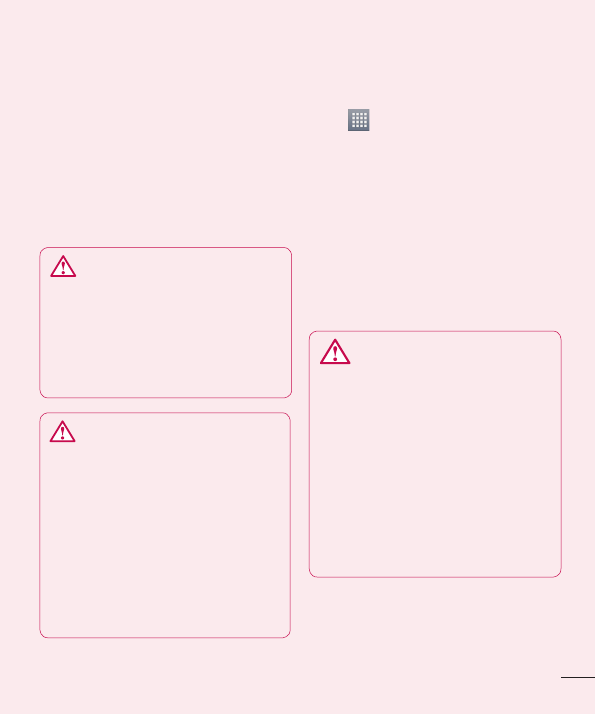
11
phone to a power source or, if currently
connected, how long the phone was last
running on battery power. The screen
shows the applications or services using
battery power, listed in order from the
greatest to smallest amount used.
3. Before installing an open
source application and OS
WARNING
If you install and use an OS other
than the one provided by the
manufacturer it may cause your
phone to malfunction. In addition,
your phone will no longer be
covered by the warranty.
WARNING
To protect your phone and
personal data, only download
applications from trusted sources,
such as Play Store™. If there are
improperly installed applications
on your phone, it may not work
normally or a serious error may
occur. You must uninstall those
applications and all associated data
and settings from the phone.
4. Using unlock pattern
Set unlock pattern to secure your phone.
Touch > Apps tab > Settings >
Lock screen from DEVICE > Select
screen lock > Pattern.This opens a
screen that guide you through how to
draw a screen unlock pattern. You have to
create a Backup PIN as a safety measure
if you forgot pattern lock.
Caution: Create a Google account
before setting an unlock pattern and
remember Backup PIN you created
while creating Pattern lock.
WARNING
Precautions to take when using
pattern lock.
It is very important to remember
the unlock pattern you set. You will
not be able to access your phone
if you use an incorrect pattern 5
times. You have 5 opportunities
to enter your unlock pattern, PIN
or password. If you have used all
5 opportunities, you can try again
after 30 seconds.
When you can’t recall your unlock
Pattern, PIN, or Password:
< If you have forgotten pattern >
If you logged in to your Google account
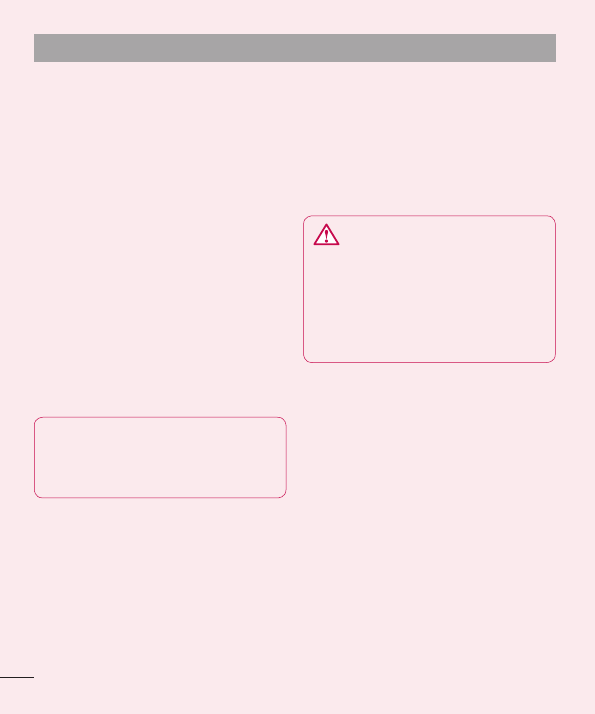
12
on the phone but failed to enter the
correct pattern 5 times, tab the Forgot
Pattern button on the bottom of the
screen. You are then required to log in
with your Google Account or you have to
enter Backup PIN which you entered while
creating Pattern Lock.
If you have not created a Google account
on the phone or you forgot Backup PIN,
you have to perform a hard reset.
< If you have forgotten PIN or
Password >
If you forgot your PIN or Password, you
need to do hard reset.
Caution: If you perform a hard reset,
all user applications and user data are
deleted.
Note: If you have not logged in
Google Account and forgot Unlock
Pattern, you need to enter Backup
PIN.
5. Using the hard reset
(Factory reset)
If your phone does not restore to the
original condition, use a Hard Reset
(Factory Reset) to initialize it.
Turn the power off.
Press and hold the Power/Lock key
+ Volume Down key.
1
2
Once LG Logo appears on the screen,
release all Keys.
After some seconds, allow you to
select factory reset function in the
Android system recovery utility.
Scroll the list by Volume keys and
select it by Power/Lock key.
WARNING
If you perform a Hard Reset, all
user applications, user data and
DRM licenses will be deleted.
Please remember to back up any
important data before performing a
Hard Reset.
6. Opening and switching
applications
Multitasking is easy with Android because
you can keep more than one application
running at the same time. There's no
need to quit an application before opening
another. Use and switch between several
open applications. Android manages each
application, stopping and starting them
as needed to ensure that idle applications
don't consume resources unnecessarily.
3
4
5
Important notice

13
To return to view list recently used
applications:
Simply press Recent apps key
To stop applications:
Touch > Apps tab > Settings >
Apps > Running
Scroll and touch the desired applica-
tion and touch Stop to stop it.
7. Installing PC Software (LG
PC Suite)
"LG PC Suite" PC Application is a program
that helps you connect your device to
a PC via a USB cable and Wi-Fi. Once
connected, you can use the functions of
your device from your PC.
With your "LG PC Suite" PC
Application, You Can...
Manage and play your media contents
(music, movie, pictures) on your PC.
Send multimedia contents to your
device.
Synchronizes data (schedules, contacts,
bookmarks) in your device and PC.
Backup the applications in your device.
Update the softwares in your device.
Backup and restore the device.
Play multimedia contents of your PC
from your device.
1
2
•
•
•
•
•
•
•
NOTE: You can use the Help menu
from the application to find out
how to use your "LG PC Suite" PC
application.
Installing "LG PC Suite" PC Application
"LG PC Suite" PC application can be
downloaded from the webpage of LG.
Go to www.lg.com and select a coun-
try of your choice.
Go to Support > MOBILE SUPPORT
> LG Mobile Phones > Select the
Model (LG-E972) or Go to Support >
Mobile Phone Support > Select the
Model (LG-E972).
Click PC Sync from MANUALS &
DOWNLOAD, and click DOWNLOAD to
download “LG PC Suite” PC software
or Click PC Sync from Download, and
click WINDOW PC Sync Download to
download "LG PC Suite" PC software.
System Requirements for "LG PC
Suite" PC software
OS: Windows XP 32 bit(Service pack 2),
Windows Vista 32 bit/64 bit, Windows 7
32 bit/64 bit
CPU: 1 GHz or higher processors
Memory: 512 MB or higher RAMs
Graphic card: 1024 x 768 resolution,
1
2
3
•
•
•
•

14
32 bit color or higher
HDD: 100 MB or more free hard disk
space (More free hard disk space may
be needed depending on the volume of
data stored.)
Required software: LG integrated drivers,
Windows Media Player 10 or later
NOTE: LG Integrated USB Driver
LG integrated USB driver is
required to connect an LG device
and PC and installed automatically
when you install "LG PC Suite" PC
software.
8. Synchronizing your phone
to a Computer
Data from your device and PC can be
synchronized easily with "LG PC Suite"
PC application for your convenience.
Contacts, schedules, and bookmarks can
be synchronized.
The procedure is as follows:
Connect your device to PC. (Use a USB
cable or Wi-Fi connection.)
After connection, run the program
and select the device section from the
category on the left side of the screen.
Click [Personal information] to select.
•
•
1
2
3
Select the checkbox of contents to
synchronize and click the Sync button.
9. Synchronizing your phone
to a computer via USB
NOTE: To synchronize your phone
with your PC using the USB cable,
you need to install LG PC Suite
onto your PC.
Please refer to previous pages to
install LG PC Suite.
Touch > Apps tab > Settings >
Storage from the DEVICE to check out
the storage media.
Connect the phone to your PC using
the USB cable.
USB connection type list will appear in
your phone screen, and select Media
sync (MTP) option.
Open the memory folder on your PC.
You can view the mass storage con-
tent on your PC and transfer the fi les.
Copy the fi les from your PC to the
drive folder.
Select Charge only option to discon-
nect the phone.
4
1
2
3
4
5
6
Important notice

15
To disconnect your phone from the
computer:
Open the notification drawer and touch
> Charge only to disconnect your
phone from the computer safely.
10. Hold your phone upright
Hold your mobile phone vertically, as you
would a regular phone. The LG-E972 has
an internal antenna. Be careful not to
scratch or damage the back of the phone,
as this may affect performance.
While making/receiving calls or sending/
receiving data, avoid holding the lower
part of the phone where the antenna is
located. Doing so may affect call quality.
11. When the screen freezes
If the screen freezes or the phone
does not respond when you try to
operate it:
Press and hold the Power/Lock key for
10 seconds to turn it off.
If it still does not work, please contact the
service centre.
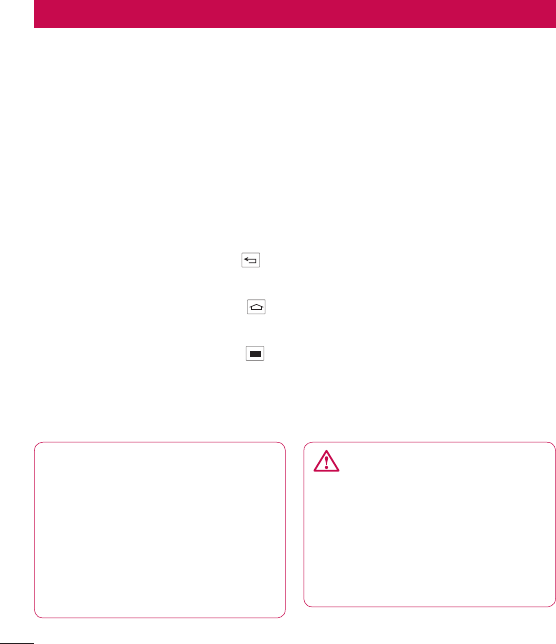
16
Phone overview
Earpiece
Front-Facing Camera lens
Proximity / Luminance Sensor
Home key
Return to the home screen from any screen.
Back key
Return to the previous screen.
Power/Lock key
Switch your phone on/off by pressing and holding this key.
Short press to lock/unlock the screen.
•
•
Menu key
Check what options are available.
Go to Google Search™ by touching and holding this key.
•
•
Touch screen
Notification flash
NOTE: Proximity sensor
When receiving and making calls,
the proximity sensor automatically
turns the backlight off and locks
the touch screen by sensing when
the phone is near your ear. This
extends battery life and prevents
you from unintentionally activating
the touch screen during calls.
WARNING
Placing a heavy object on the
phone or sitting on it can damage
the LCD and touch screen
functions. Do not cover the LCD
proximity sensor with protective
film. This could cause the sensor to
malfunction.
Getting to know your phone
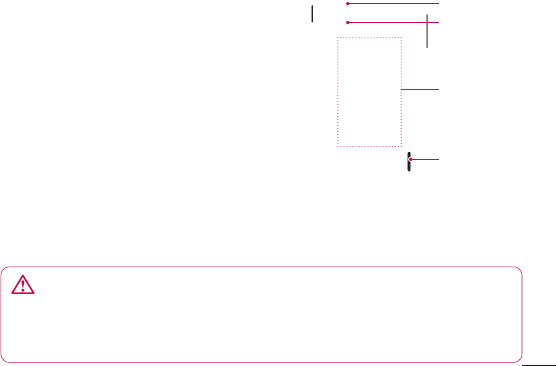
17
WARNING
• Encloses the battery compartment. Please do not open the back cover.
• Be careful not to damage the NFC touch point of the phone that is the part
of the NFC antenna.
Earphone Jack
Flash
Speaker
Charger/USB port
Microphone
Camera lens
Microphone
NFC touch
point

18
Getting to know your phone
Installing the Micro-USIM card
Before you start exploring your new phone, you may insert the Micro-USIM card.
The eject button is a small round aperture just above the tray door. To install a new
Micro-USIM card:
Insert the SIM ejection tool that comes with the phone (or a thin pin) into the eject
button aperture, and push fi rmly but gently until the tray pops out.
Remove the tray and place the Micro-USIM card inside it, with the contacts out and
the angled corner to the right. There is only one possible way to fi t the card snugly
into the tray.
Carefully reposition the tray in the slot and push it gently back into the phone.
NOTE: Make sure the gold contact area on the card is facing downwards.

19
Charging the phone
The charger connector is at the bottom of the phone. Insert one end of the charging
cable into the phone and plug the other end into an electrical socket.
NOTE: The battery must be fully charged initially to improve battery lifetime.
Locking and unlocking the screen
If you do not use the phone for a while, the screen is turned off and locked
automatically. This helps to prevent accidental touches and saves battery power.
When you are not using the LG-E972, press the Power/Lock key to lock your
phone.
If there are any programs running when you set lock screen, they may be still running
in Lock mode. It is recommended that you exit all programs before entering Lock mode
to avoid unnecessary charges (e.g. phone calls, web access and data communications).
To wake up your phone, press the Power/Lock key . The lock screen will
appear. Touch and slide the lock screen in any direction to unlock your home screen.
The last screen you viewed will open.
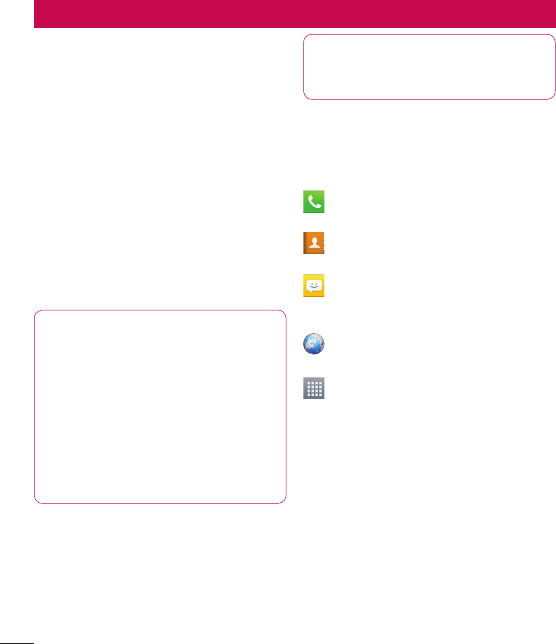
20
Your Home screen
Touch screen tips
Here are some tips on how to navigate
around your phone.
Touch – To choose a menu/option or
open an application, touch it.
Touch and hold – To open an options
menu or grab an object you want to move,
touch and hold it.
Drag – To scroll through a list or move
slowly, drag across the touch screen.
Flick – To scroll through a list or move
quickly, flick across the touch screen (drag
quickly and release).
NOTE:
To select an item, touch the centre
of the icon.
Do not press too hard; the touch
screen is sensitive enough to pick up
a light, firm touch.
Use the tip of your finger to touch
the option you want. Be careful not
to touch any other keys.
•
•
•
Home
Simply swipe your finger to the left or right
to view the panels. You can customize
each panel with Apps, Downloads,
Widgets and wallpapers.
NOTE: Some screen images may
be different depending on your
phone provider.
On your home screen, you can view menu
icons at the bottom of the screen. Menu
icons provide easy, one-touch access to
the functions you use the most.
Touch the Phone icon to bring up the
touch screen dialpad to make a call.
Touch the Contacts icon to open your
contacts.
Touch the Messaging icon to access
the messaging menu. This is where
you can create a new message.
Touch the Browser icon to access the
web browser.
Touch the Apps icon at the bottom of
the screen. You can then view all your
installed applications. To open any
application, simply touch the icon in
the applications list.
Customizing the Home screen
You can customize your home screen
by adding Apps, Downloads, Widgets or
Wallpapers. For more convenience using
your phone, add your favourite apps and
widgets to the home screen.
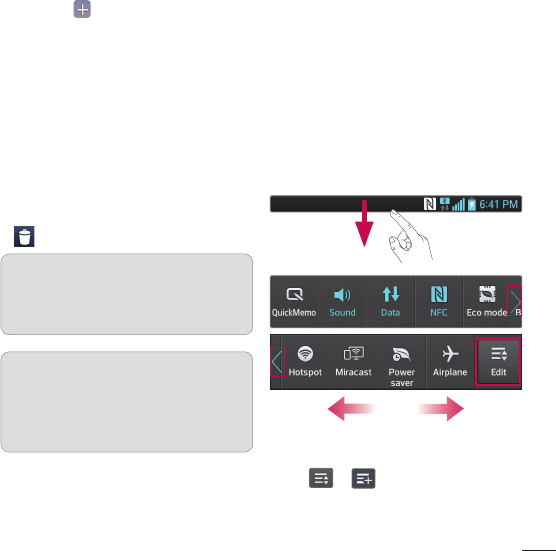
21
To add items on your home screen:
Touch and hold the empty part of the
home screen.
Or touch at the top of the right
side.
In the Add Mode menu, select items
you want to add. You will then see
added items on the home screen.
Drag it to the location you want and lift
your fi nger.
To remove an item from the home
screen:
Home screen > touch and hold the
icon you want to remove > drag it to
TIP! To add an application icon
to the home screen from the
Apps menu, touch and hold the
application you want to add.
TIP! Using folders
You can combine several app icons
in a folder. Drop one app icon over
another on a home screen, and the
two icons will be combined.
1
2
3
•
Returning to recently-used
applications
Touch and hold the Home key. The
screen displays a pop-up with icons of
applications you used recently.
Touch an icon to open the application.
Or touch the Back key to return to
your previous screen.
Notification drawer
The notification drawer runs across the
top of your screen.
Touch and slide the notification drawer
down with your finger.
Touch > to manage the
notification panel.
1
2
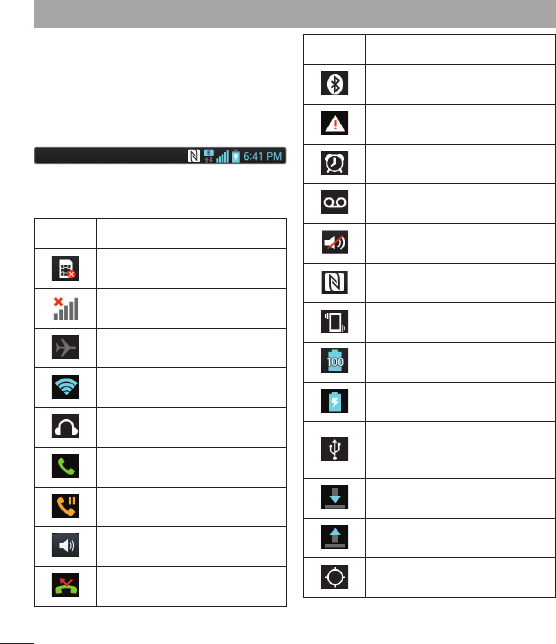
22
Viewing the status bar
The status bar uses different icons to
display phone information such as signal
strength, new messages, battery life,
active Bluetooth and data connections.
Below is a table explaining the meaning of
icons you're likely to see in the status bar.
Icon Description
No Micro-USIM card
No signal
Airplane mode
Connected to a Wi-Fi network
Wired headset
Call in progress
Call hold
Speakerphone
Missed call
Icon Description
Bluetooth is on
System warning
Alarm is set
New voicemail
Ringer is silenced
NFC is on
Vibrate mode
Battery fully charged
Battery is charging
Phone is connected to PC via
USB cable
Downloading data
Uploading data
GPS is acquiring
Your Home screen
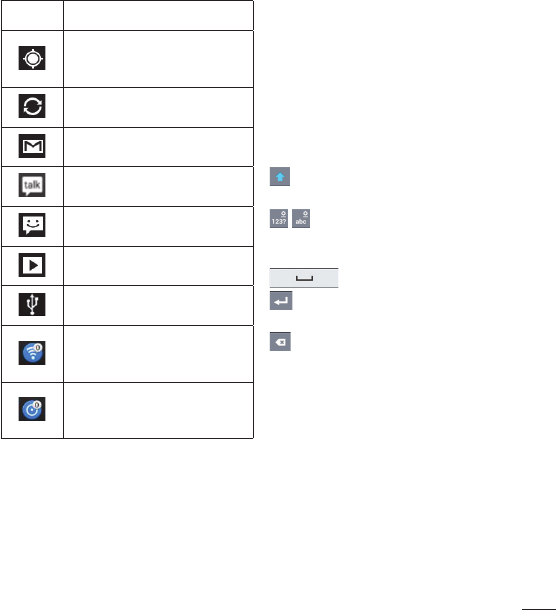
23
Icon Description
Receiving location data from
GPS
Data is syncing
New Gmail
New Google Talk message
New message
Song is playing
USB tethering is active
Portable Wi-Fi hotspot is
active
Both USB tethering and
portable hotspot are active
Onscreen keyboard
You can enter text using the onscreen
keyboard. The onscreen keyboard appears
automatically on the screen when you
need to enter text. To manually display the
keyboard, simply touch a text field where
you want to enter text.
Using the keypad & entering text
Tap once to capitalize the next letter
you type. Double-tap for all caps.
Tap to switch to the numbers and
symbols keyboard. You can also touch and
hold this tab to view the Settings menu.
Tap to enter a space.
Tap to create a new line in the
message field.
Tap to delete the previous character.
Entering accented letters
When you select French or Spanish as the
text entry language, you can enter special
French or Spanish characters (e.g. "á").
For example, to input "á", touch and hold
the "a" key until the zoom-in key grows
bigger and displays characters from
different languages.
Then select the special character you
want.

24
Google account set up
When you first turn on your phone, you
have the opportunity to activate the
network, to sign into your Google Account
and how you want to use some Google
services.
To set up your Google account:
Sign into a Google Account from the
prompted set up screen.
OR
Touch > Apps tab > select a
Google application, such as Gmail >
select New to create a new account.
If you have a Google account, touch
Existing, enter your email address and
password, then touch Sign in.
Once you have set up your Google
account on your phone, your phone
automatically synchronizes with your
Google account on the web.
Your contacts, Gmail messages, Calendar
events and other information from these
applications and services on the web
are synchronized with your phone. (This
depends on your synchronization settings.)
After signing in, you can use Gmail™
and take advantage of Google services on
your phone.
•
•
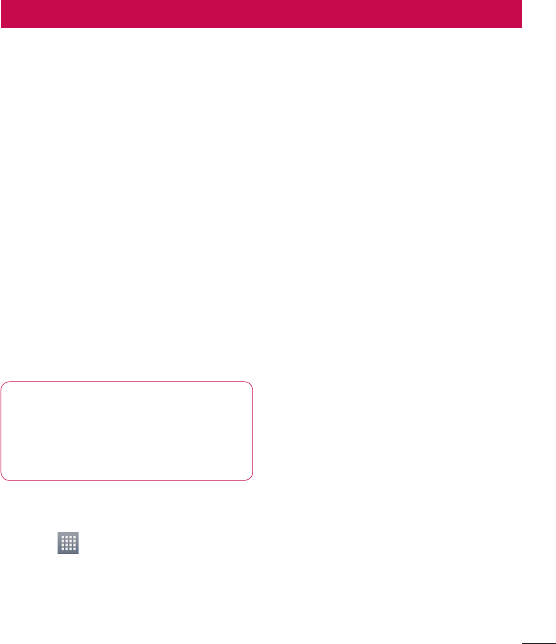
25
Connecting to Networks and Devices
Wi-Fi
With Wi-Fi, you can use high-speed
Internet access within the coverage of
the wireless access point WAP. Enjoy
wireless Internet using Wi-Fi, without extra
charges.
Connecting to Wi-Fi networks
To use Wi-Fi on your phone, you need
to access a wireless access point or
"hotspot". Some access points are
open and you can simply connect to
them. Others are hidden or use security
features, you must configure your phone
to be able to connect to them.
Turn off Wi-Fi when you're not using it to
extend the life of your battery.
NOTE: If you are out of the Wi-Fi
zone or set Wi-Fi to OFF, additional
charges may be applied by your
mobile operator for mobile data
use.
Turning Wi-Fi on and connecting to a
Wi-Fi network
Touch > Apps tab > Settings
> Wi-Fi from the WIRELESS &
NETWORKS
Set Wi-Fi to ON to turn it on and start
scanning for available Wi-Fi networks.
1
2
Tap Wi-Fi menu again to see a list of
active and in-range Wi-Fi networks.
Secured networks are indicated by a
lock icon.
Touch a network to connect to it.
If the network is secured, you are
prompted to enter a password or
other credentials. (Ask your network
administrator for details)
After connecting to a Wi-Fi
network,the status bar displays icon
that indicate Wi-Fi status.
3
•
4
•
5
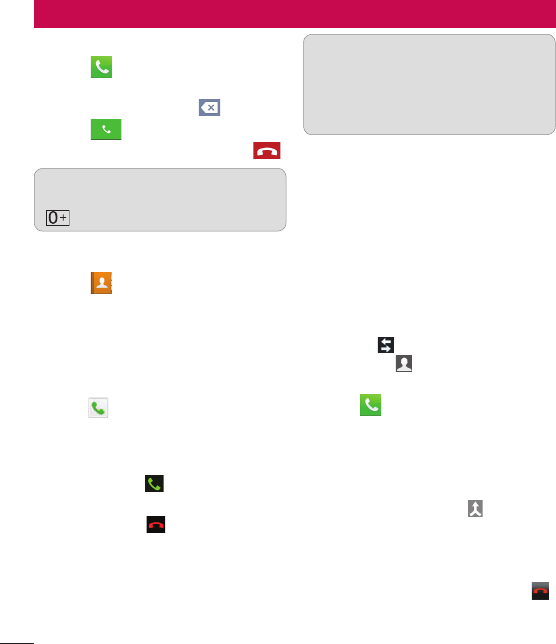
26
Calls
Making a call
Touch to open the keypad.
Enter the number using the keypad. To
delete a digit, touch the .
Touch to make a call.
To end a call, touch the End icon .
TIP! To enter "+" to make
international calls, touch and hold
.
Calling your contacts
Touch to open your contacts.
Scroll through the contact list or enter
the fi rst few letters of the contact
you want to call by touching Search
contacts.
In the list, touch the contact twice or
touch you want to call.
Answering and rejecting a call
When you receive a call in Lock state,
hold and slide the to Answer incoming
call.
Hold and slide the to Decline an
incoming call.
Hold and slide the Quick msg icon
from the bottom if you want to send a
message.
1
2
3
4
1
2
3
TIP! Quick messages
You can send a message quickly
using this function. This is useful
if you need to reject a call with
message during a meeting.
Adjusting the in-call volume
To adjust the in-call volume during a call,
use the Volume up and down keys on the
left-hand side of the phone.
Making a second call
During your fi rst call, touch Menu >
Add call and dial the number. Also,
you can go recent dialled list by
touching or can search contacts
by touching and select the contact
you want to call.
Touch to make the call.
Both calls are displayed on the call
screen. Your initial call is locked and
put on hold.
Touch the displayed number to toggle
between calls. Or touch Merge
call to make a conference call.
To end active calls, touch End or press
Home Key and slide the notifi cation
bar down and select End call icon .
1
2
3
4
5
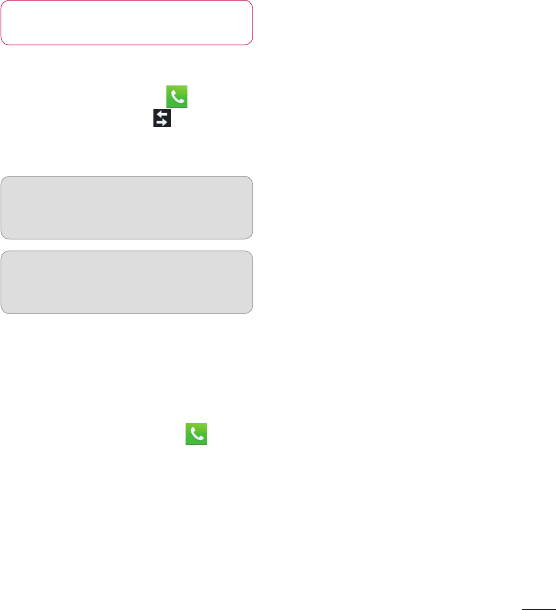
27
NOTE: You are charged for each
call you make.
Viewing your call logs
On the home screen, touch and
choose the Call logs tab .
View a complete list of all dialled, received
and missed calls.
TIP! Touch any call log entry to
view the date, time and duration of
the call.
TIP! Press the Menu key, then
touch Delete all to delete all the
recorded items.
Call settings
You can configure phone call settings
such as call forwarding and other special
features offered by your carrier.
On the home screen, touch .
Touch the Menu key.
Tap Call settings and choose the
options that you want to adjust.
1
2
3
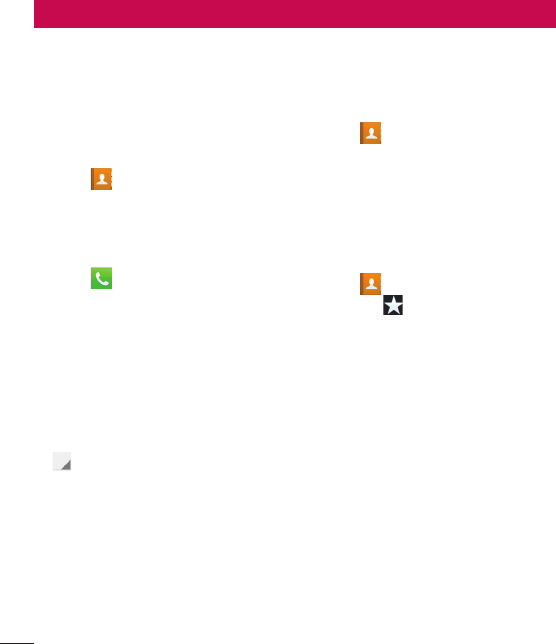
28
Contacts
Add contacts to your phone and
synchronize them with the contacts in
your Google account or other accounts
that support contact syncing.
Searching for a contact
In the home screen
Touch to open your contacts.
Touch Search contacts and enter the
contact name using the keyboard.
Adding a new contact
Touch , enter the new contact's
number, then press the Menu key.
Touch Add to Contacts > Create
new contact.
If you want to add a picture to the new
contact, touch the image area.
Choose from Take photo or Select
from Gallery.
Select the contact type by touching
.
Touch a category of contact informa-
tion and enter the details about your
contact.
Touch Save.
1
2
1
2
3
4
5
Favourite contacts
You can classify frequently called contacts
as favourites.
Adding a contact to your favourites
Touch to open your contacts.
Touch a contact to view their details.
Touch the star to the right of the
contact's name. The star turns yellow
color.
Removing a contact from your
favourites list
Touch to open your contacts.
Touch the tab, and choose a
contact to view its details.
Touch the yellow color star to the right
of the contact's name. The star turns
grey and the contact is removed from
your favourites.
1
2
3
1
2
3

29
Moving contacts from your
Old Device to your New
Device
Export your contacts as a CSV file from
your old device to your PC using a PC
sync program.
Install "LG PC Suite" on the PC fi rst.
Run the program and connect your
Android mobile phone to the PC using
a USB cable.
On the top menu, select Device >
Import to device > Import contacts.
A popup window to select the fi le type
and a fi le to import will appear.
On the popup, click the Select a fi le
and Windows Explorer will appear.
Select the contacts fi le to import in
Windows Explorer and click the Open.
Click OK.
A Field mapping popup to link the
contacts in your device and new
contacts data will appear.
If there is a confl ict between the data
in your PC contacts and device con-
tacts, make the necessary selections
or modifi cations in LG PC Suite.
Click OK.
1
2
3
4
5
6
7
8
9
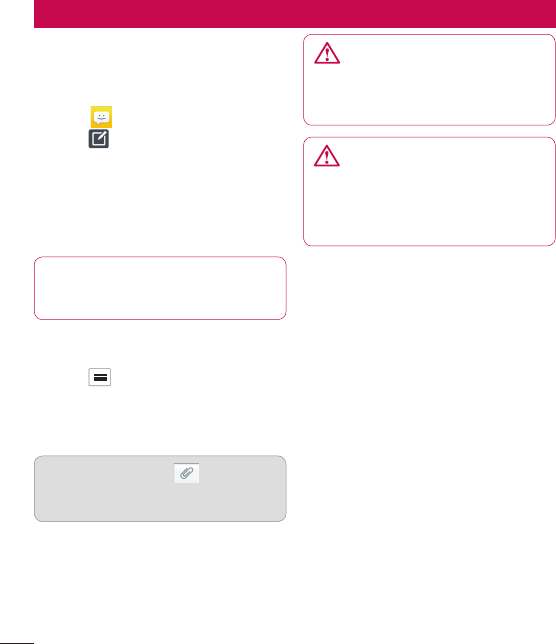
30
Messaging
Your LG-E972 combines SMS and MMS
into one intuitive, easy-to-use menu.
Sending a message
Touch on the home screen, and
touch to open a blank message.
Enter a contact name or contact
number in the To fi eld. As you enter
the contact name, matching contacts
appear. You can touch a suggested re-
cipient. You can add multiple contacts.
NOTE: You will be charged for a
text message for every person you
send the message to.
Touch Enter message fi eld and start to
compose your message.
Press to open the Options menu.
Choose from Change skin, Add sub-
ject, Quick messages, Insert smilry
and Discard.
TIP! You can touch icon to
attach the file you want to share
with your message.
Touch Send to send your message.
Responses appear on the screen. As
you view and send additional mes-
sages, a message thread is created.
1
2
3
4
5
6
WARNING: The 160-character
limit may vary from country to
country depending on the language
and how the SMS is coded.
WARNING: If an image,
video or audio file is added to an
SMS message, it is automatically
converted into an MMS message
and you are charged accordingly.
Threaded box
Messages (SMS, MMS) exchanged
with another party can be displayed
in chronological order so that you can
conveniently see an overview of your
conversation.
Changing your message
settings
Your LG-E972 message settings are
predefined, so you can send messages
immediately. You can change the settings
based on your preferences.
Touch Messaging icon on the home
screen, and touch the Menu key, then
tap Settings.
•

31
E-mail
You can use the E-mail application to
read emails from services like Gmail. The
E-mail application supports the following
account types: POP3, IMAP and Exchange.
Your service provider or system
administrator can provide the account
settings you need.
Managing an email account
The first time you open the E-mail
application, a setup wizard opens to help
you to set up an email account.
After the initial setup, E-mail displays the
contents of your inbox. If you have added
more than one account, you can switch
among accounts.
To add another email account:
Touch > Apps tab > E-mail
> touch > Accounts > in the
Accounts screen, touch > Add
account.
To change an email account's setting:
Touch > Apps tab > E-mail
> touch > Accounts > in the
Accounts screen, touch > Entire
settings.
•
•
To delete an email account:
Touch > Apps tab > E-mail
> touch > Accounts > in the
Accounts screen, touch > Remove
account > touch an account you want
to delete > Remove > select Yes.
Working with account folders
Touch > Apps tab > E-mail, touch
and select Folders.
Each account has an Inbox, Outbox,
Sent and Drafts folder. Depending on the
features supported by your account's
service provider, you may have additional
folders.
Composing and sending email
To compose and send a message
While in the E-mail application, touch
the .
Enter an address for the message's
intended recipient. As you enter text,
matching addresses are offered from
your Contacts. Separate multiple ad-
dresses with semicolon.
Touch Cc/Bcc fi eld to add Cc/Bcc and
Touch to attach fi les if required.
Enter the text of the message.
•
1
2
3
4

32
Touch the .
If you aren't connected to a network,
for example, if you're working in
airplane mode, the messages that you
send are stored in your Outbox folder
until you're connected to a network
again. If it contains any pending mes-
sages, the Outbox is displayed on the
Accounts screen.
TIP! When a new email arrives
in the inbox, you will receive a
notification by sound or vibration.
Tap the email notification to stop
notifications.
5
E-mail
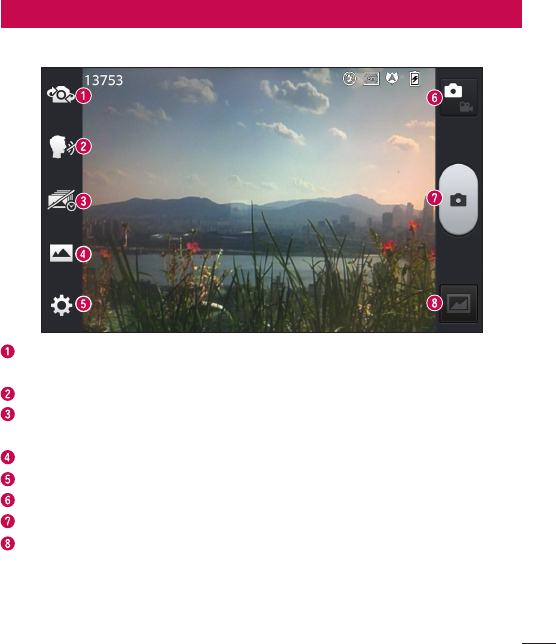
33
Camera
Getting to know the viewfinder
Swap camera – Switch between the rear–facing camera lens and the front–facing
camera lens.
Cheese shutter – Say "Cheese" when you get ready to take a photo.
Time catch shot – Touch this icon to capture the missing moment before pressing
the shutter.
Shot mode – Choose from Normal, HDR, Panorama or Continuous shot.
Settings – Touch this icon to open the Settings menu.
Video mode – Touch this icon to switch to video mode.
Taking a photo
Gallery – Touch to view the last photo you captured. This enables you to access
your gallery and view saved photos within camera mode.
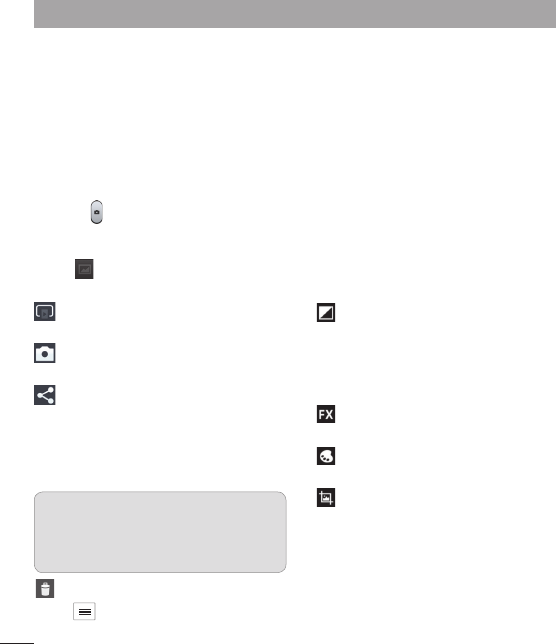
34
Taking a quick photo
Open the Camera application.
Hold the phone, point the lens towards
the subject you want to photograph.
Touch the screen and a focus box will
appear in the viewfi nder screen.
When the focus box turns green, the
camera has focused on your subject.
Touch to capture the photo.
Once you've taken the photo
Touch to view the last photo you
captured.
Touch to share your photo via
SmartShare function.
Touch to take another photo
immediately.
Touch to share your photo via
Bluetooth, E-mail, Facebook,
FileShare, Gmail, Google+, Memo,
Messaging, Picasa, Social+ or
Twitter.
TIP! If you have an SNS account
and set it up on your phone, you
can share your photo with the SNS
community.
Touch to delete the photo.
Touch to open the options.
1
2
3
4
5
Set image as – Touch to use the photo
as a Contact photo, Home Screen
wallpaper or Lockscreen Wallpaper.
Move – Touch to move the photo to other
place.
Copy – Touch to copy the selected photo
and save it to other album.
Rename – Touch to edit the name of the
selected picture.
Rotate left/right – To rotate left or right.
Crop – Crop your photo. Move your finger
across the screen to select the area.
Edit – View and edit the picture.
Select the photo resolution. If you
choose the high resolution, the file
size will increase, which means you
will be able to store fewer photos in
the memory.
Improves colour qualities in different
lighting conditions.
Applies artistic effects to the
pictures.
Applies the additional options for
pictures.
Slideshow – Automatically shows you the
images one after the other.
Details – Find out more information about
the contents.
Camera
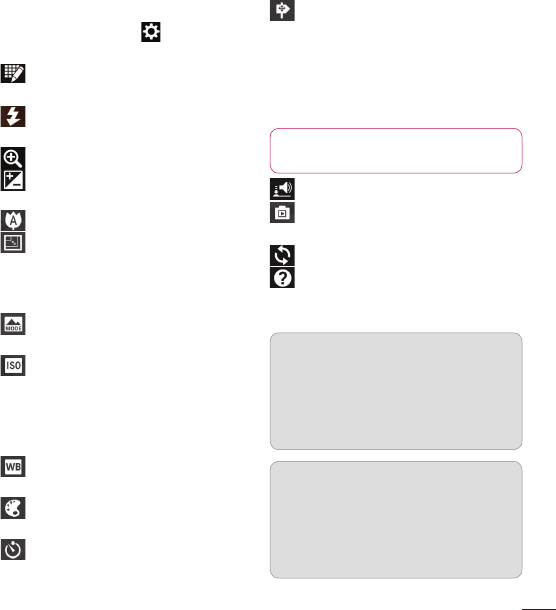
35
Using the advanced settings
In the viewfinder, touch to open all
advanced options.
– Touch if you want to change the
viewfinder menu.
– Allows you to turn on the flash
when taking a photo in dark conditions.
– Zoom in or out
– This defines and controls the
amount of sunlight entering the photo.
– Focuses on the specific spot.
– Select the photo resolution. If you
choose the high resolution, the file size
will increase, which means you will be
able to store fewer photos in the memory.
– Finds the color and light settings
appropriate for the current environment.
– The ISO rating determines the
sensitivity of the camera's light sensor.
The higher the ISO, the more sensitive
the camera is. This is useful in darker
conditions when you cannot use the flash.
– Improves colour qualities in
different lighting conditions.
– Applies artistic effects to the
pictures.
– Set a delay after the capture button
is pressed. This is ideal if you want to be
in the photo.
– Activate to use your phone's
location-based services. Take pictures
wherever you are and tag them with the
location. If you upload tagged pictures to
a blog that supports geotagging, you can
see the pictures displayed on a map.
NOTE: This function is only
available when GPS is active.
– Select one of shutter sounds.
– It automatically shows you the
picture you just took.
– Restore all camera default settings.
– Touch whenever you want to
know how some function operates. This
provides you with a quick guide.
TIP! When you exit the camera,
some settings return to their
defaults, such as white balance,
colour tone, timer and scene mode.
Check these before you take your
next photo.
TIP! The Settings menu is
superimposed over the viewfinder
so, when you change elements
of the photo colour or quality, you
see a preview of the image change
behind the Settings menu.
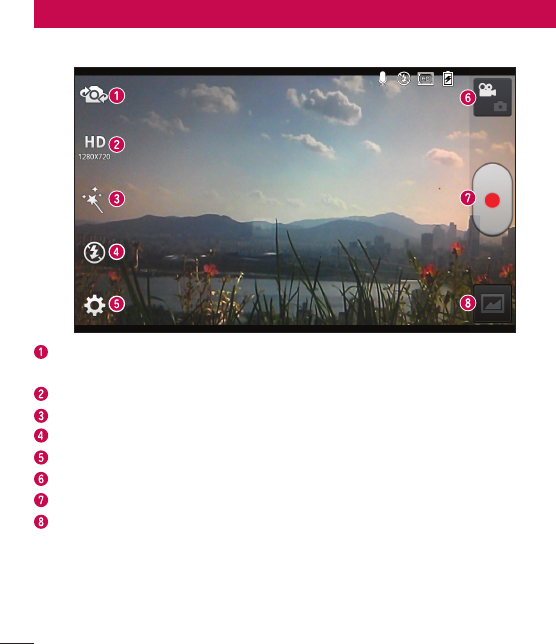
36
Video camera
Getting to know the viewfinder
Swap camera – Switch between the rear–facing camera lens and the front-facing
camera lens.
Video size – Touch to set the size (in pixels) of the video you are recording.
Live effect – Live effect provides various visual effects when taking a video.
Flash – Allows you to turn on the flash when taking a video in dark conditions.
Settings – Touch this icon to open the settings menu.
Camera mode – Touch this icon to switch to camera mode.
Start recording
Gallery – Touch to view the last video you recorded. This enables you to access your
gallery and view your saved videos from within video mode.